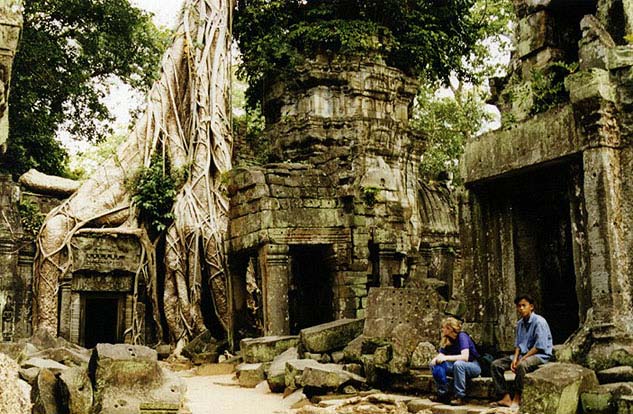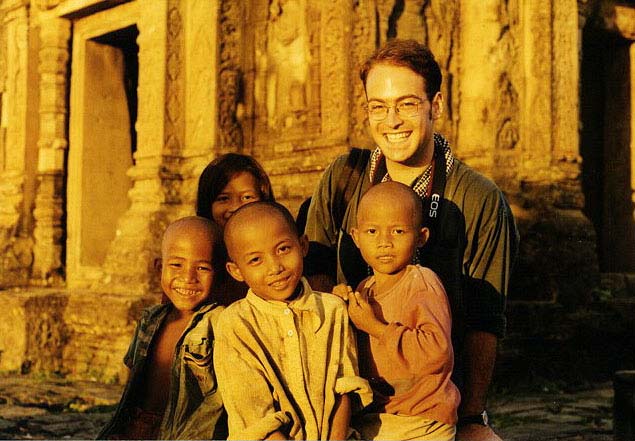 |
| Andy and some new friends at sunset, Phnom Bakheng |
Monday Afternoon, November 10
Saying Goodbye to Angkor
Lunch was again at the Bayon Restaurant. We hadn't had any breakfast that morning, so we attacked several plates of baguettes and jam with ravenous abandon. During our extended break, we returned to the central market to buy souvenirs. Susanne picked up two papier mache masks like the ones used the previous afternoon by the Khmer dancers. The masks were wrapped and boxed for safekeeping, but I worried they wouldn't make it in our backpacks. At $3 a mask, Susanne said, it was worth trying. I thought about buying a wooden ornamental pipe, but every pipe I found had Chinese characters on them - not very Khmer if you ask me. I got a bit frustrated that every item on sale looked like it was made in Hong Kong, and I really wanted to bring home something that would say "Cambodia" to me when I thought about it. I bought a small wooden boat modeled after the boats used in the Bonn Tuk Oum festival, but I still wasn't completely satisfied. I'd look more later, I guess.
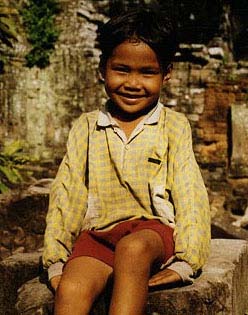 |
| Da, our young guide to Banteay Kdei |
At 2pm we met up with Rang and returned to Angkor's Big Circuit. We started with Banteay Kdei, a large 12th century Buddhist temple. Several girls were selling t-shirts outside and we suggested to them that we might buy one after we visited the temple if they stopped hounding us. They backed off and sat down, waiting impatiently for our return. We were joined by two boys, one of whom couldn't have been more than six or seven years old, the other perhaps 12 or 14. We weren't looking for a guide, but the older boy began to spout interesting facts about Jayavarman VII and the use of avian Garuda images on Buddhist temples. We invited them along. I asked them how old they were, and the older boy said he was 16. "No way," I said, "12, 14, right?" To this he responded "No, sir. 16 years old. We Cambodians are much smaller than you." True, whenever we had asked others how old they were, we always seemed to guess five years too young. Maybe it was true - Cambodians certainly are smaller, so maybe that makes them look younger as well. I also wondered if malnutrition made a difference, but I didn't ask. I'd have to check with some Khmer friends back home. We also asked the younger boy, whose name was Da, how old he was. "Seventeen?" he said with some doubt.
and the use of avian Garuda images on Buddhist temples. We invited them along. I asked them how old they were, and the older boy said he was 16. "No way," I said, "12, 14, right?" To this he responded "No, sir. 16 years old. We Cambodians are much smaller than you." True, whenever we had asked others how old they were, we always seemed to guess five years too young. Maybe it was true - Cambodians certainly are smaller, so maybe that makes them look younger as well. I also wondered if malnutrition made a difference, but I didn't ask. I'd have to check with some Khmer friends back home. We also asked the younger boy, whose name was Da, how old he was. "Seventeen?" he said with some doubt.
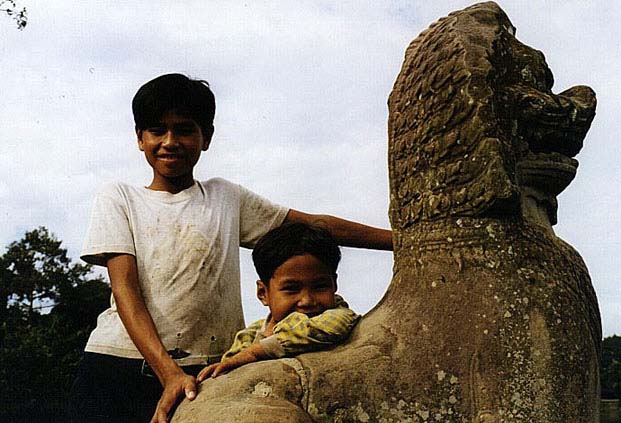 |
| Da and his friend lounging at Sras Srang |
Banteay Kdei was devoid of visitors so we admired its carvings and its ancient moat in peaceful solitude. The moat now looked like a pond in a city park, complete with crickets and floating lotus. The t-shirt girls then reappeared, and after haggling down to $3 a shirt we bought a couple of them. Before driving off, we crossed the road to Sras Srang, a 12th century reservoir with a short terrace and several nice statues. The two boys horsed around on one of the statues by the water's edge. We soon said goodbye and returned to Rang's car.
We then paid a brief visit to Prasat Kravan - five brick towers from the 10th century. They were restored in the 1960s to the point that they almost felt like replicas of what the original towers might have looked like. I didn't care for the freshness of the brick; it just didn't seem like they fit into the rest of Angkor. The site also had an inordinate number of kids for such a small temple. About 25 children jumped rope, played tag and messed around on the temple platform. Some of the kids were selling charcoal rubbings so I approached the youngest of them asked to see some. He couldn't have been more than five or six, but he rolled out his pictures and said, "10 dollars, mister." I found a beautiful image of a royal court scene, so I pointed to it and said "five dollars." The little boy turned to some older children and conferred with them in Khmer, holding his hand in front of his lips so I couldn't see what he was saying. He then turned back to me and said, "six dollars." I figured the older kids would have told him to press for eight dollars, but who was I to argue? I counted out my singles one by one and made the deal with him. We were both quite happy.
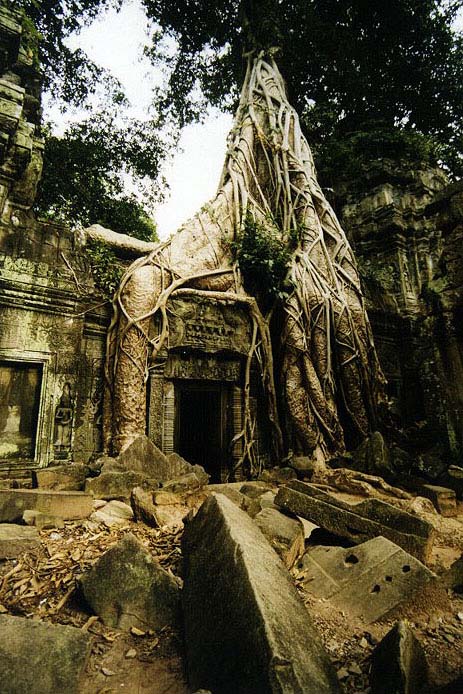 |
| A tree-entwined passageway, Ta Prohm |
For the next temple, we headed to Ta Prohm. Ta Prohm is a popular destination here for it's the only large temple at Angkor that is still fully encroached by jungle. So a visit to Ta Prohm isn't too far removed from what the French explorers of the 19th century would have found here. At the entrance to the site, a young man offered to be our guide. At first we weren't interested but then I remembered that the LP guide suggested to get one of the local kids to show you around, since they knew all the great photogenic spots. So we ran back after him and agreed to hire him for part of the afternoon. His name was Meas and he was 18. Again, I would have said 15, but I kept my mouth shut. As we approached the temple a high pitch shrieking sound emanated from the forest. It was like a far alarm going off in a stairwell - I didn't think nature made noises this loud. We asked Meas what the sound was but he didn't know the English word for the particular animal that was making all the noise. After playing a brief game of charades and hand gestures we concluded the noise was coming from hundreds of small frogs.
Ta Prohm was an Indiana Jones adventure brought to life, or perhaps the Disney World Jungle Cruise. Either metaphor would have been appropriate: towers of stone twisted by tree roots, some hundreds of years old; bas reliefs distorted by seven centuries of lichens and moss. We climbed through the rubble, marveling at the Tolkeinesque sight of these gargantuan trees had taken root and spread over the temple walls, producing some of the most famous and recognizable images of Angkor. The further we ventured into the temple, the older and grander the trees seemed to grow. At the center of the temple courtyard, Meas scampered higher and higher in his flip flops as we tried to keep up. The next thing I realized we were perched high atop a shattered temple wall, 30 feet or more from the ground. I was too awestruck by the view to be terrified of a misstep. The forest was alive with the chirps and calls of birds, monkeys, more frogs. It was an uncanny, otherworldly experience. Cautiously we returned to solid earth and backtracked to the entrance of the temple to meet up with Rang.
It was getting close to 4:30pm and we still had the Ta Keo temple on our itinerary, but we were both beat and eager to get to Phnom Bakheng for sunset. Rang took us by Ta Keo for a brief look, and we stepped outside for a few minutes to appreciate it. But Phnom Bakheng beckoned us, so we purchased some bottled water and headed to the foot of the hill. We slowly climbed the 300-foot mound, its gravel path providing less than adequate footing. Eventually we reached the top, the highest point at Angkor. Four kids had followed us up the hill and we soon struck up a conversation with them. There was one girl named Suan and three boys: Lee, Phaeng and Hing. They spoke little English but were very giggly and outgoing. Suan tried to help me up the temple steps by grabbing my hand, which actually made my balance on these aging steps all the more difficult. But I didn't want to spoil the moment.
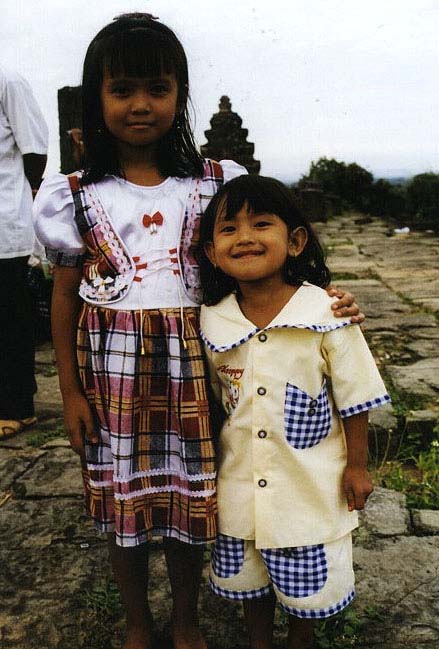 |
| Two Khmer sisters, Phnom Bakheng |
Up top, we could see Angkor Wat in the distance, but without a telephoto lens or binoculars it was hard to get a clear view of it. Facing west, though, the sun descended over the waters of the Tonle Sap, reflecting reddish hues across the temple terrace. The kids were having a merry time playing tag and they mugged for countless photos, which we couldn't resist. We had our own little photo shoot going on with these youngsters, taking at least a roll of film's worth of pictures. There was also a Khmer family, sitting on the rocks with their cameras and cans of Coke. They had two little girls who were sneaking peeks at me and Susanne. I smiled at them and said "Johm riab sua." After some motherly encouragement, the smaller of the two girls ran towards me, bowed her head with her hands pressed together by her chin and yelled "Johm riab sua!" back to me. Her parents laughed approvingly. I reciprocated the bow and then said to her in Khmer, "Aw kohn charan. Sabai te?" to which she responded with another enthusiastic "Johm riab sua!" I quickly grabbed my Cambodia guide and looked up the phrases for "What is your name?" and "My name is Andy." I struggled terribly; Khmer is so difficult for westerners to pronounced. I kept on trying to get the words for "my name is" - khnyom chhmeu, if I remember correctly - but they didn't roll of the tongue the way I had hoped. Nevertheless, the girl played along with my conversation until she got a case of the shy bug and ran back to her daddy. It was my first and last productive conversation in Khmer.
I sat on the terrace peacefully as the sun set over Angkor. For me, this was closure for Cambodia. The last three days had gone exceptionally well; I really was going to miss this country and its beautiful people. Susanne also seemed quite content at this fleeting moment. As the sun vanished below the horizon, we made our way slowly down the hill's gravel slope. The four kids were now joined by two others as they led the way down. At the bottom of the hill, though, they all turned to me and said "now you pay - one dollar to each." I was so disappointed. I tried offering them the handful of riels I had left and the last two dollars left in my pocket. They pouted and continued to demand more money. This really ticked me off, because it was clear they were having a good time up there, and to expect a dollar for each and every one of them was stretching it for me. Susanne seemed to feel sincerely bad about not having enough money on hand, but after seeing their testy reaction, I decided it was tough luck for them. They'd get more money from tourists after school tomorrow.
Rang took us back to Siem Reap and drove us around on a wild goose chase to find some baguettes for the next morning. None of the bakeries were open but we managed to find a food stall with a brick oven and fresh bread. They only accepted riels, so Rang ran across the street, got a couple dollars changed for us, and made the purchase of four baguettes for 100 riels each. Back at the hotel, we made plans for Rang to take us to the airport the next morning. Meanwhile, I paid him the balance of his fee plus an extra 20 dollar tip. He was worth every penny, as he served as our driver, translator, guide, concierge, and any other position we might have needed to fill. We then returned to our rooms and packed, for tomorrow would be a travel day. It was almost time to leave Cambodia.


 and the use of avian Garuda images on Buddhist temples. We invited them along. I asked them how old they were, and the older boy said he was 16. "No way," I said, "12, 14, right?" To this he responded "No, sir. 16 years old. We Cambodians are much smaller than you." True, whenever we had asked others how old they were, we always seemed to guess five years too young. Maybe it was true - Cambodians certainly are smaller, so maybe that makes them look younger as well. I also wondered if malnutrition made a difference, but I didn't ask. I'd have to check with some Khmer friends back home. We also asked the younger boy, whose name was Da, how old he was. "Seventeen?" he said with some doubt.
and the use of avian Garuda images on Buddhist temples. We invited them along. I asked them how old they were, and the older boy said he was 16. "No way," I said, "12, 14, right?" To this he responded "No, sir. 16 years old. We Cambodians are much smaller than you." True, whenever we had asked others how old they were, we always seemed to guess five years too young. Maybe it was true - Cambodians certainly are smaller, so maybe that makes them look younger as well. I also wondered if malnutrition made a difference, but I didn't ask. I'd have to check with some Khmer friends back home. We also asked the younger boy, whose name was Da, how old he was. "Seventeen?" he said with some doubt. 

